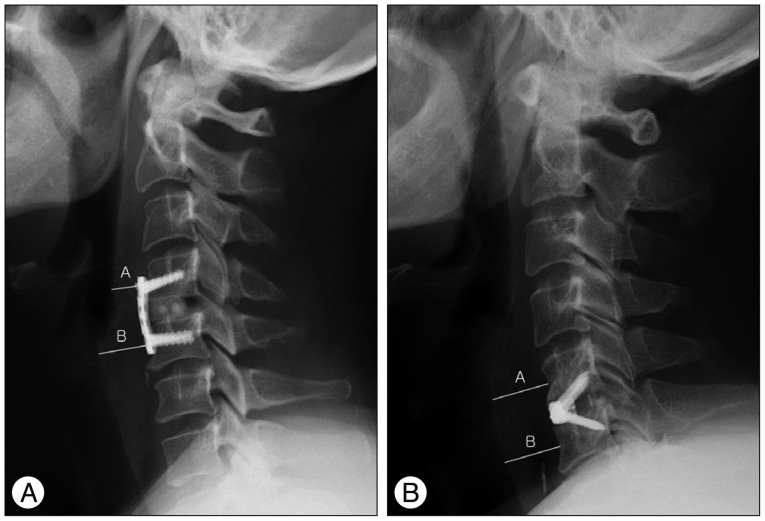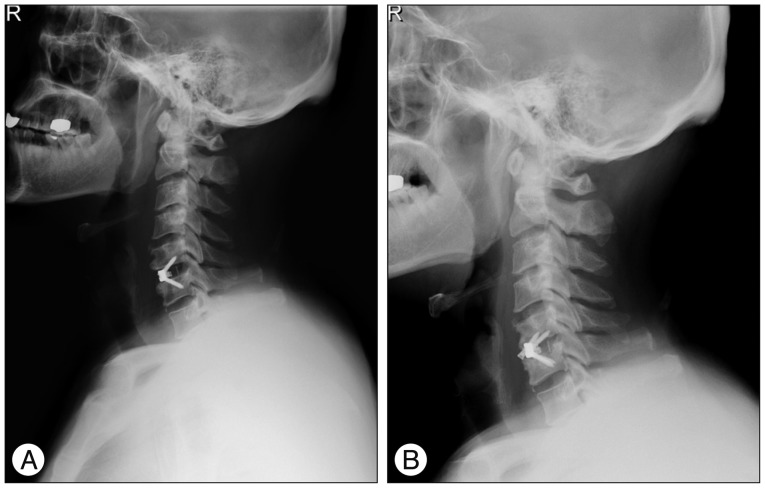J Korean Neurosurg Soc.
2014 Aug;56(2):103-107. 10.3340/jkns.2014.56.2.103.
Comparative Study of Clinical and Radiological Outcomes of a Zero-Profile Device Concerning Reduced Postoperative Dysphagia after Single Level Anterior Cervical Discectomy and Fusion
- Affiliations
-
- 1Department of Neurosurgery, Pusan National University Yangsan Hospital, Yangsan, Korea. md6576@naver.com
- 2Department of Neurosurgery, Maryknoll Hospital, Busan, Korea.
- KMID: 1956511
- DOI: http://doi.org/10.3340/jkns.2014.56.2.103
Abstract
OBJECTIVE
This study analyzed clinical and radiological outcomes of a zero-profile anchored spacer (Zero-P) and conventional cage-plate (CCP) for single level anterior cervical discectomy and fusion (ACDF) to compare the incidence and difference of postoperative dysphagia with both devices.
METHODS
We retrospectively reviewed our experiences of single level ACDF with the CCP and Zero-P. From January 2011 to December 2013, 48 patients who had single level herniated intervertebral disc were operated on using ACDF, with CCP in 27 patients and Zero-P in 21 patients. Patients who received more than double-level ACDF or combined circumferential fusion were excluded. Age, operation time, estimated blood loss (EBL), pre-operative modified Japanese Orthopaedic Association (mJOA) scores, post-operative mJOA scores, achieved mJOA scores and recovery rate of mJOA scores were assessed. Prevertebral soft tissue thickness and postoperative dysphagia were analyzed on the day of surgery, and 2 weeks and 6 months postoperatively.
RESULTS
The Zero-P group showed same or favorable clinical and radiological outcomes compared with the CCP group. Postoperative dysphagia was significantly low in the Zero-P group.
CONCLUSIONS
Application of Zero-P may achieve favorable outcomes and reduce postoperative dysphagia in single level ACDF.
Keyword
MeSH Terms
Figure
Cited by 2 articles
-
Can the Zero-Profile Implant Be Used for Anterior Cervical Discectomy and Fusion in Traumatic Subaxial Disc Injury? A Preliminary, Retrospective Study
Tae Hun Kim, Dae Hyun Kim, Ki Hong Kim, Young Seok Kwak, Sang Gyu Kwak, Man Kyu Choi
J Korean Neurosurg Soc. 2018;61(5):574-581. doi: 10.3340/jkns.2018.0090.Cervical Stand-Alone Polyetheretherketone Cage versus Zero-Profile Anchored Spacer in Single-Level Anterior Cervical Discectomy and Fusion : Minimum 2-Year Assessment of Radiographic and Clinical Outcome
Hyun-Jun Cho, Junseok W. Hur, Jang-Bo Lee, Jin-Sol Han, Tai-Hyoung Cho, Jung-Yul Park
J Korean Neurosurg Soc. 2015;58(2):119-124. doi: 10.3340/jkns.2015.58.2.119.
Reference
-
1. Barbagallo GM, Romano D, Certo F, Milone P, Albanese V. Zero-P : a new zero-profile cage-plate device for single and multilevel ACDF. A single institution series with four years maximum follow-up and review of the literature on zero-profile devices. Eur Spine J. 2013; 22(Suppl 6):S868–S878. PMID: 24061968.2. Bazaz R, Lee MJ, Yoo JU. Incidence of dysphagia after anterior cervical spine surgery : a prospective study. Spine (Phila Pa 1976). 2002; 27:2453–2458. PMID: 12435974.3. Benzel EC. Cervical spondylotic myelopathy. J Neurosurg. 1995; 83:942–943. PMID: 7472574.
Article4. Cloward RB. The anterior approach for removal of ruptured cervical disks. J Neurosurg. 1958; 15:602–617. PMID: 13599052.
Article5. Fountas KN, Kapsalaki EZ, Nikolakakos LG, Smisson HF, Johnston KW, Grigorian AA, et al. Anterior cervical discectomy and fusion associated complications. Spine (Phila Pa 1976). 2007; 32:2310–2317. PMID: 17906571.
Article6. Hirabayashi K, Satomi K. Operative procedure and results of expansive open-door laminoplasty. Spine (Phila Pa 1976). 1988; 13:870–876. PMID: 3143157.
Article7. Kalb S, Reis MT, Cowperthwaite MC, Fox DJ, Lefevre R, Theodore N, et al. Dysphagia after anterior cervical spine surgery : incidence and risk factors. World Neurosurg. 2012; 77:183–187. PMID: 22155226.
Article8. Kim SW, Limson MA, Kim SB, Arbatin JJ, Chang KY, Park MS, et al. Comparison of radiographic changes after ACDF versus Bryan disc arthroplasty in single and bi-level cases. Eur Spine J. 2009; 18:218–231. PMID: 19127374.
Article9. Korinth MC. Treatment of cervical degenerative disc disease - current status and trends. Zentralbl Neurochir. 2008; 69:113–124. PMID: 18666050.
Article10. Lee MJ, Bazaz R, Furey CG, Yoo J. Influence of anterior cervical plate design on Dysphagia : a 2-year prospective longitudinal follow-up study. J Spinal Disord Tech. 2005; 18:406–409. PMID: 16189451.11. Li Y, Hao D, He B, Wang X, Yan L. The efficiency of zero-profile implant in anterior cervical discectomy fusion : a prospective controlled long-term follow-up study. J Spinal Disord Tech. 2013; [Epub ahead of print].12. Mummaneni PV, Kaiser MG, Matz PG, Anderson PA, Groff MW, Heary RF, et al. Cervical surgical techniques for the treatment of cervical spondylotic myelopathy. J Neurosurg Spine. 2009; 11:130–141. PMID: 19769492.
Article13. Park JB, Cho YS, Riew KD. Development of adjacent-level ossification in patients with an anterior cervical plate. J Bone Joint Surg Am. 2005; 87:558–563. PMID: 15741622.
Article14. Pitzen TR, Chrobok J, Stulik J, Ruffing S, Drumm J, Sova L, et al. Implant complications, fusion, loss of lordosis, and outcome after anterior cervical plating with dynamic or rigid plates : two-year results of a multi-centric, randomized, controlled study. Spine (Phila Pa 1976). 2009; 34:641–646. PMID: 19287352.
Article15. Scholz M, Schnake KJ, Pingel A, Hoffmann R, Kandziora F. A new zero-profile implant for stand-alone anterior cervical interbody fusion. Clin Orthop Relat Res. 2011; 469:666–673. PMID: 20882376.
Article16. Song KJ, Choi BW, Kim HY, Jeon TS, Chang H. Efficacy of postoperative radiograph for evaluating the prevertebral soft tissue swelling after anterior cervical discectomy and fusion. Clin Orthop Surg. 2012; 4:77–82. PMID: 22379559.
Article
- Full Text Links
- Actions
-
Cited
- CITED
-
- Close
- Share
- Similar articles
-
- Surgical Outcome of a Zero-profile Device Comparing with Stand-alone Cage and Anterior Cervical Plate with Iliac Bone Graft in the Anterior Cervical Discectomy and Fusion
- Analysis of Noninstrumented Anterior Cervical Discectomy and Interbody Fusion in Degenerative Cervical Disease
- The Advantages of Rectangular Titanium Cage(RABEA) Fusion after Anterior Cervical Discectomy: Comparative Study of Fibula Allograft
- Comparative Study of Clinical Outcomes of Anterior Cervical Discectomy and Fusion Using Autobone Graft or Cage with Bone Substitute
- Improvement of Dysphagia after Anterior Cervical Screw Removal: Case Report




